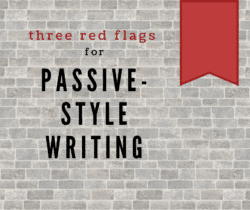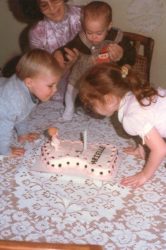
If there’s one thing to be said about passive stories, it’s that they’re boooooring. The reader is either asleep or has moved on to something else. The narrative reads like a summary of what happened—the version you’d tell someone on the phone—not one where the reader is immersed and feels like they’re experiencing the events themselves. It’s a common problem for writers and one that takes practice to address.
Here is a story written in passive style:
We made cupcakes in the kitchen at my house where we grew up. The ingredients were easy to find in the pantry. After mixing everything together, the batter was ready. We put the tray in the oven, set the timer, and waited until they were done. My sister was the best with icing. She made it nice and neat. Then she told me to smell the icing. When I did, she shoved the cupcake up my nose.
While this has some story-like elements, it’s still a summary of an event (an unfortunately true event, where my sister learned she could pull this trick on her gullible little sister multiple times). Here are three red flags that help identify passive writing.
Red Flag One: No Dialogue
When you’re rereading your story and you notice paragraph after paragraph where you’re telling an event and there’s no dialogue, it could very likely be written in a passive style. Dialogue is one element of creating a scene, the goal you’re trying to reach with narrative writing. A scene is multidimensional while passive writing is flat. A scene includes character thoughts and feelings, aspects of setting, and elements of show-not-tell—not just the events that happened. Dialogue is a key component of constructing a scene. Rework your story to add dialogue and make the characters more active.
Red Flag Two: Passive Verbs
Passive verbs are a key indicator of passive writing, particularly if there are a high number of them. They include was, were, is, are, had been, and will be. A good tool is the “Find” feature in your word processor. It counts how many of a specific word you have and where they are located. In the example above, there are four passive verbs. Trade out the passive verbs for more active ones and see how you can make your sentences more lively.
Red Flag Three: No Sense of the Present
This isn’t referring to whether or not the story is written in past or present tense. It’s the feeling of “I’m in this moment now” when I’m reading it. The story is an immersive experience and I’m emotionally tied to what comes next. The author’s voice is apparent and compelling. In passive-style writing, there can often be lots of “info dumping” or telling the reader chunks of information. It’s quite underwhelming and the reader feels less grounded in the story. Try slowing down your pacing and adding character reactions and thoughts.
Let’s look at that example story again, this time written in a more active style.
Adventures in the kitchen with my sister always involved a few surprises. We often made cupcakes together, me managing the ingredients and Amber working all the appliances.
“The icing’s almost ready,” she announced over the whir of the hand mixer.
I grinned and circled near the cupcakes cooling on the rack. Butter and vanilla had weaved together in the air, tormenting my senses for the last twenty minutes. Not much longer now.
“Grab one and bring it here.”
I complied in record time. “Can I have the first one?”
“Sure.”
That was a quick yes. She usually fought me on things like this…fought me on everything, actually. I suppressed my suspicion. Sugary goodness was seconds away.
Amber swirled a ribbon of chocolate on top. She inhaled. “This smells amazing. You have to smell it.”
I leaned forward, closer to the must-be-in-my-belly confection. The rich scent tantalized my nose and I knew—
A rush of chocolate and cake crammed into my nose. Amber howled.
The second example includes dialogue, character thoughts, and limited passive verbs. It has the elements of a scene and a feeling of the present instead of reading like a summary of what happened. In short, it’s active instead of passive. Shifting your narrative writing from passive to active requires practice but takes your story from being a series of events to a total experience for the reader.


Anne
Great info. – thanks!!
Paul
Another concise bit of advise. Thanks!
Ken Pelham
Brilliantly spelled out for us, Arielle! Thanks.